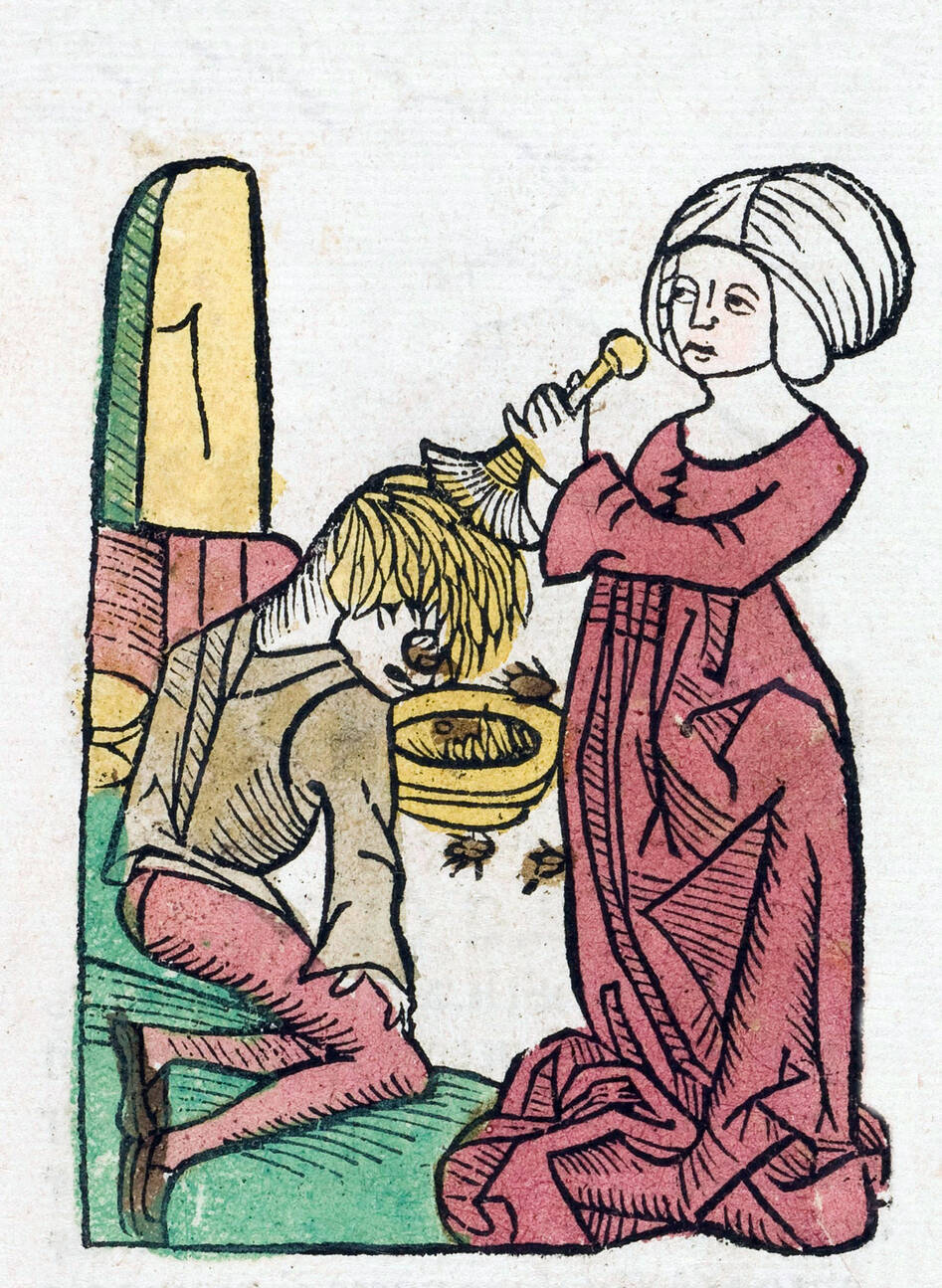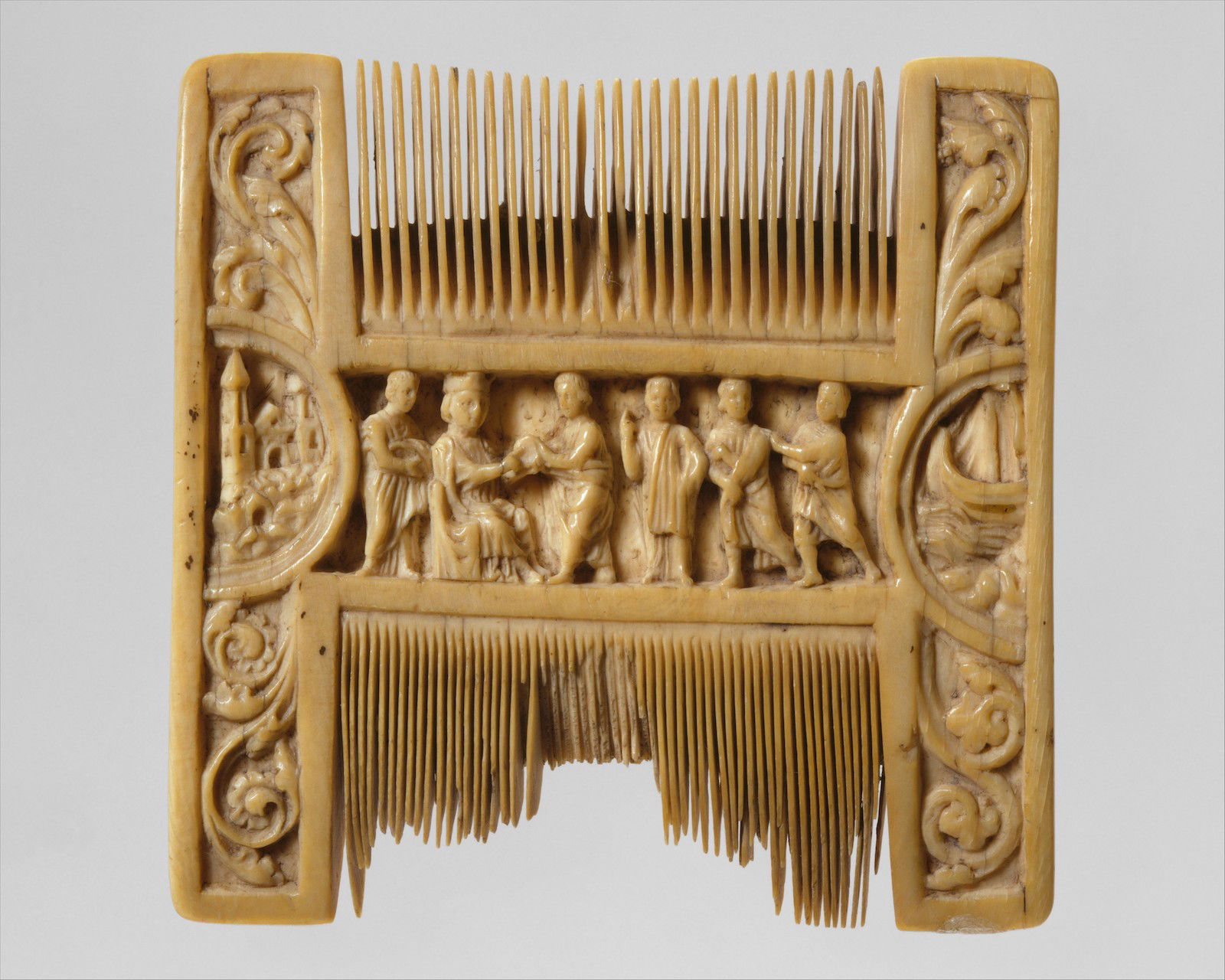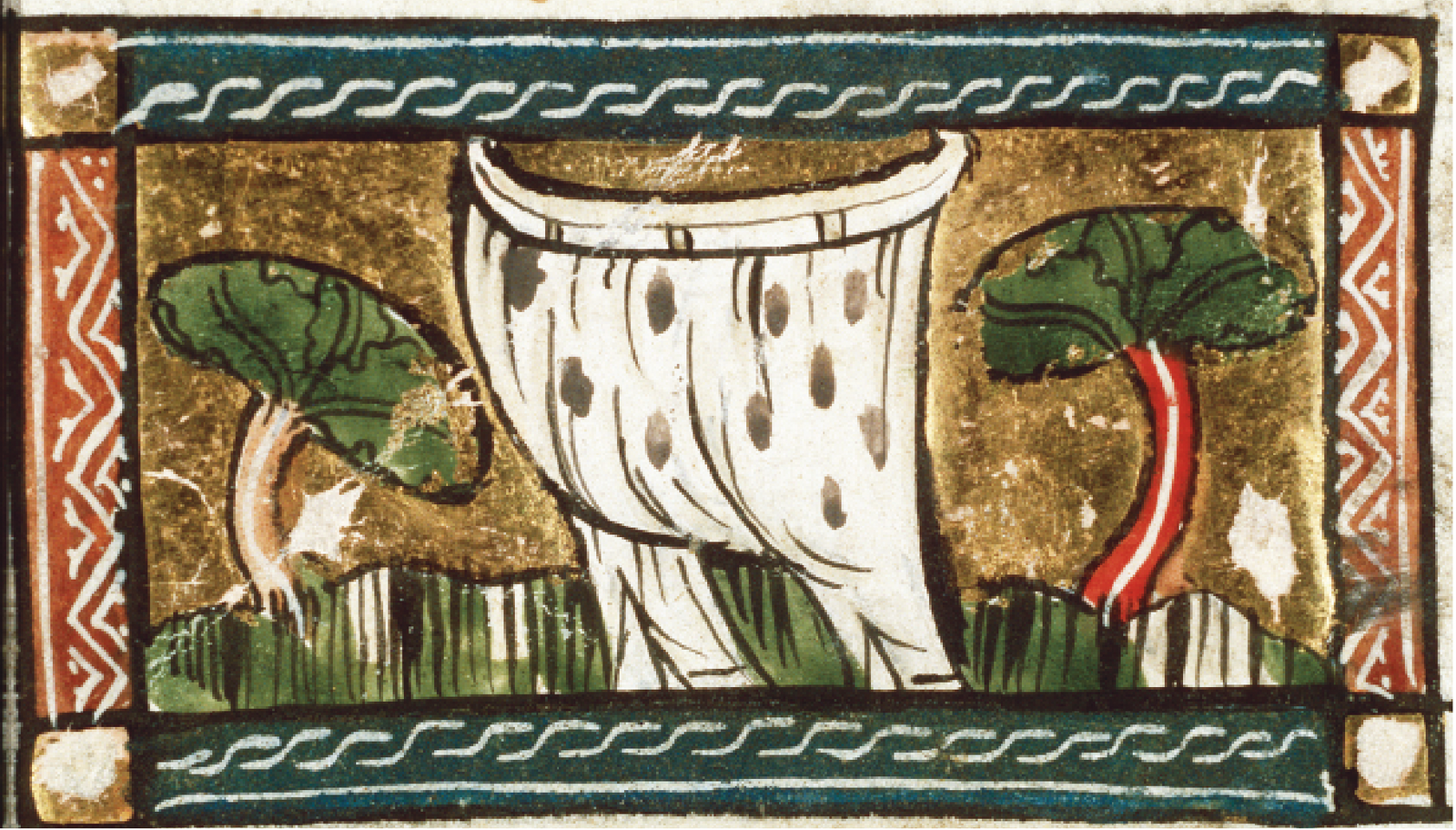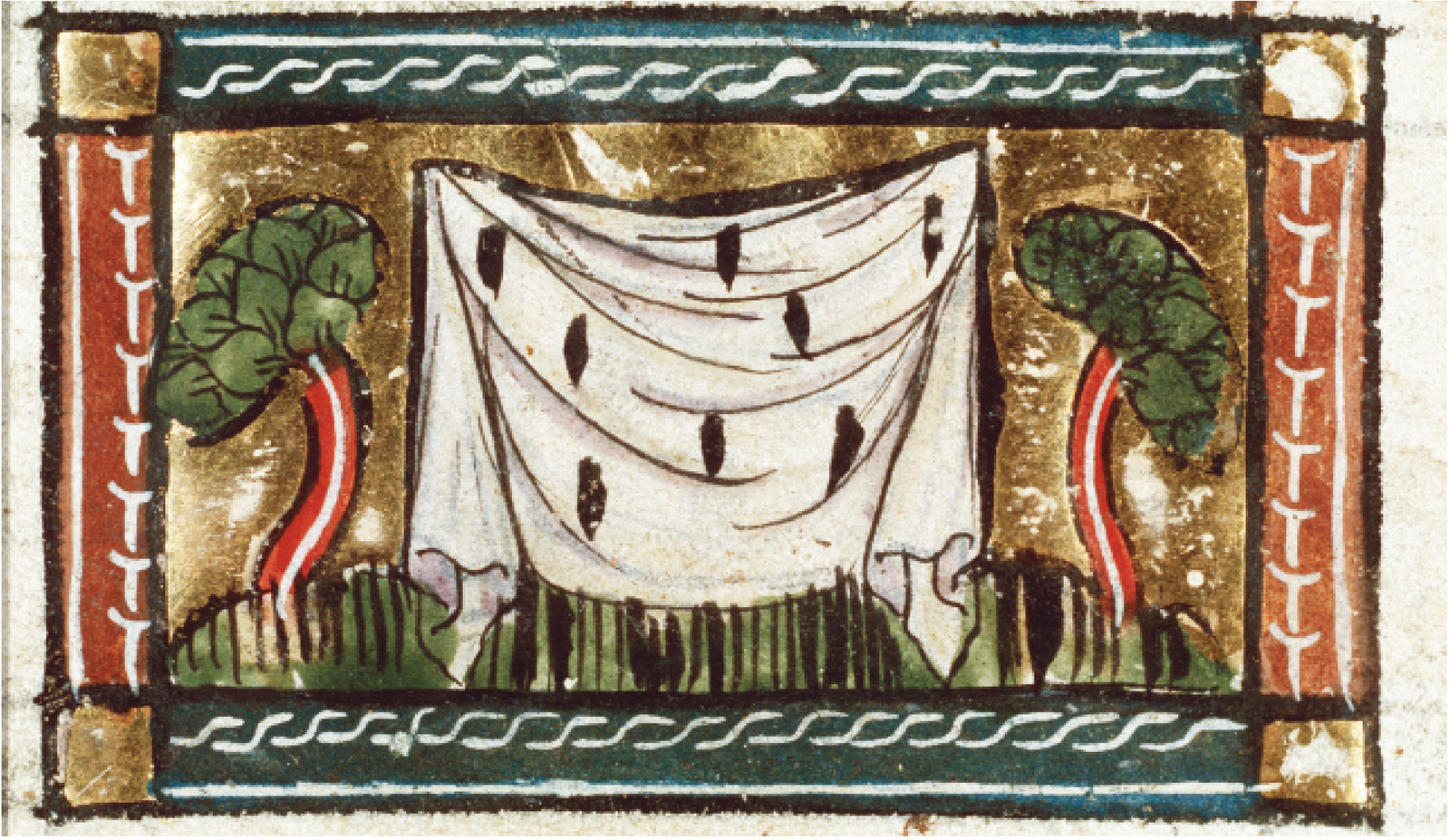The Flies, Fleas and Rotting Flesh of Medieval Monks

In December 1170, in the hours after the shocking murder of Thomas Becket, the monks of Canterbury Cathedral prepared his body for burial. While doing so, they made a surprising discovery: the archbishop, a former courtier who was not particularly known for his piety, was wearing hair undergarments. What was more:
This goat hair underwear was swarming, inside and out, with minute fleas and lice, masses of them all over in large patches, so voraciously attacking his flesh that it was nothing short of a miracle that he was able to tolerate such punishment.
Rather than being repulsed by this revelation, the monks viewed the vermin as further proof of the martyr’s sanctity, and Becket’s hair shirt became an important element of his cult. It was preserved at Canterbury, where it was viewed by countless pilgrims and celebrated in liturgy. Tiny fragments of this precious garment were given to high-status relic collectors from across Europe and were credited with numerous healing miracles.
Although Becket was probably the most high-profile practitioner of this unlikely form of asceticism, he was certainly not unique; medieval hagiography is littered with graphic depictions of saintly infestations. A few years after Becket’s death, a Benedictine monk named Reginald of Durham wrote a life of a local hermit, Godric of Finchale (c.1070-1170), in which he described how:
In the great heat of summer, his excessive sweat generated a plague of worms, a huge multitude of which most savagely consumed his flesh, and the shaggy roughness of his hair shirt used to provide complete nourishment for a great crowd of them.
(Despite the reference to worms, Godric was almost certainly suffering from body lice. Whereas we make clear distinctions between different types of parasite, medieval categorisations were rather blurrier; lice were sometimes described as ‘worms with feet’.)
Nor was this some strange English practice: continental mystics engaged in similar mortifications of the flesh, among them Arnulf, an early 13th-century lay brother at the Cistercian abbey of Villers in Brabant, who wore a horse-hair cord around his body. This rope became firmly embedded in his flesh, which ‘began to rot and wriggle with worms’. The 14th-century Dominican mystic Henry Suso was tormented by vermin so numerous that: ‘It often seemed to him that he were lying on an anthill.’ Fearing that he might derive pleasure from scratching his bites in his sleep, he wore leather gloves with sharp tacks sticking outwards, until – after 16 years of clawing at his tormented flesh – God told him to stop.

Cleanliness is next to…
As the example of Thomas Becket suggests, pious infestations were not limited to marginal figures. The wearing of the hair garments in which these creatures thrived was a relatively common practice not only among the new religious orders of this period, but also among the clerical elites. Hugh, bishop of Lincoln (d.1200), was so attached to his that he refused to remove it even on his deathbed, claiming that ‘it does not hurt me but soothes me’. Edmund of Abingdon, archbishop of Canterbury (d.1240), began to wear one as a student; his mother apparently included a replacement each time she sent him a bundle of clean laundry. Nor were such practices restricted to the clergy. Several devout aristocrats, including Simon de Montfort (d.1265), are known to have worn hair shirts.
Of course, wearing a hair shirt did not necessarily mean embracing Becket-style infestations, but several high-ranking clerics who did so were similarly afflicted. Erembald, dean of Cambrai (1093-c.1117), reportedly:
overcame his own body … by always wearing a squalid hairshirt, which he hardly ever washed and in which such an infestation of vermin swarmed that it burst forth like a bubbling stream, so that it was considered a marvel that human flesh was in any way able to endure it.
 In 1307, during the inquest into the sanctity of Thomas Cantilupe, bishop of Hereford (1275-82), his former servants described his holy lifestyle. Several testified that his bedding and clothing were full of lice; one claimed that there were whole handfuls of them. The monks of St Albans Abbey were similarly impressed by the austere life of Abbot Thomas de la Mare (d.1396), who wore hard stones and nettles under his clothes, weakening his health so that, ‘from the pressure of his hair shirt, worms teemed all over his body’.
In 1307, during the inquest into the sanctity of Thomas Cantilupe, bishop of Hereford (1275-82), his former servants described his holy lifestyle. Several testified that his bedding and clothing were full of lice; one claimed that there were whole handfuls of them. The monks of St Albans Abbey were similarly impressed by the austere life of Abbot Thomas de la Mare (d.1396), who wore hard stones and nettles under his clothes, weakening his health so that, ‘from the pressure of his hair shirt, worms teemed all over his body’.
In fact, the clergy as a whole, and especially members of the monastic orders, seem to have been associated with parasites: medical writers such as John of Gaddesden and Bernard of Gordon identified clerics as one of the social groups who were particularly prone to lice, and literary texts often play on this stereotype. In the 12th-century verse A Nun’s Lament, a young nun complains about the hardships of her life, which included poor personal hygiene: ‘The shift I wear is grim, the underwear unfresh, made of coarse thread … there’s a stench of filth in my delicate hair, and I put up with the lice that scratch my skin.’ The German Cistercian Caesarius of Heisterbach (c.1180-c.1240) recounted the story of a knight who, reluctant to become a monk because of ‘the lice that infest your robes’, is shamed into joining – for how can a brave soldier be so afraid of lice that he risks his salvation? Sometime later, the new monk is asked if he has overcome his fears and declares that ‘if all the lice of all the monks in all the world were to concentrate upon my single body, they should not bite me out of the Order’.
Often overlooked in favour of fasting and flagellation, these stories suggest that parasites were a culturally significant form of asceticism in the later Middle Ages. So why was allowing oneself to become infested with parasites considered to be a virtuous thing to do?
No pain, no gain
At the most basic level, it worked because asceticism is about pain and self-discipline, and to be infested with lice is extremely uncomfortable. Saints such as Margaret of Hungary (a 13th-century Dominican nun who refused to wash her hair so that she would be tormented by lice) knew exactly what they were doing, and deliberately sought to emulate older exemplars of Christian asceticism. The Old Testament story of Job provided a particularly influential model of such suffering: this patient man was subjected to a whole series of terrible trials, but never lost his faith in God. In later medieval Europe, it was widely believed that one of these trials involved worms, and Job is often depicted on a vermin-infested dung heap, his ragged clothes barely concealing his worm-eaten flesh. Such was his stoicism that when worms fell to the floor, he would retrieve them, in acknowledgement of the fact that his torment could only be ended by God.

Job’s sufferings were emulated by early Christians such as Simeon Stylites (d.459). When Simeon was a young monk he used hair shirts and ropes to mortify his flesh; as a consequence, his bed, his clothes and his body were full of vermin. Then, at some point during the 37 years he spent living atop a tall pillar, he developed a growth on his thigh, which produced huge numbers of worms. One day, the king of Arabs came to visit Simeon; he picked up one of the worms, which miraculously turned into a pearl, and thus the monarch was converted to Christianity. A few decades later, a Byzantine stylite named Daniel (d.493) was revered for his worm-eaten feet, while St Theodore of Sykeon (d.613) was hailed as ‘a second Job’ thanks to the vermin which covered his hair and body after a two-year stint as a cave-dweller.
Such practices arguably gained a new significance in the later Middle Ages, because a problem with parasites could be construed as a form of ‘white martyrdom’ – that is, as part of the lifestyle-based sanctity which increasingly became the norm at a time when (Becket notwithstanding) dying for one’s faith became increasingly rare. According to Guernes de Pont-Sainte-Maxence, the late 12th-century cleric who described the post-mortem discovery of Becket’s parasites:
The martyrdom he suffered when he was alive was much more painful than when he was killed in the church. Whereas in the church he died immediately and was instantaneously transported into the joy of everlasting life, all those vermin to which he was prey tormented him day and night over a number of years.
The hagiographer also asserted that these ‘masses of lice and fleas … never gave his flesh a moment’s respite’, and that: ‘For the sake of God, he continually suffered discomfort and pain.’
 Of course, parasites are not just uncomfortable, but also disgusting. That was as true in the Middle Ages as it is today. Until the 17th century, the dominant medical theory suggested that lice, fleas and worms were all produced by spontaneous generation, hatching not from eggs but formed from existing (usually unpleasant) matter. The 13th-century polymath Albertus Magnus described the louse as ‘a vermin which is generated from the putrescence at the edge of a person’s pores or which is amassed from it as it is warmed by the person’s heat in the folds of his clothing’. Consequently, a saint who wore a rarely changed hair shirt next to his sweaty (and similarly unwashed) skin would be very vulnerable to infestations. His level of risk would be enhanced if he avoided other common grooming practices, such as combing his hair and bathing. According to the English physician John of Gaddesden (1280-1361), it was this lack of self-care which made the religious especially prone to lice.
Of course, parasites are not just uncomfortable, but also disgusting. That was as true in the Middle Ages as it is today. Until the 17th century, the dominant medical theory suggested that lice, fleas and worms were all produced by spontaneous generation, hatching not from eggs but formed from existing (usually unpleasant) matter. The 13th-century polymath Albertus Magnus described the louse as ‘a vermin which is generated from the putrescence at the edge of a person’s pores or which is amassed from it as it is warmed by the person’s heat in the folds of his clothing’. Consequently, a saint who wore a rarely changed hair shirt next to his sweaty (and similarly unwashed) skin would be very vulnerable to infestations. His level of risk would be enhanced if he avoided other common grooming practices, such as combing his hair and bathing. According to the English physician John of Gaddesden (1280-1361), it was this lack of self-care which made the religious especially prone to lice.
Keen to be clean
Contrary to popular belief, medieval people understood the health benefits of good hygiene and most did their best to keep themselves clean, in part to avoid infestations. If they did become infected, they would do their best to treat the problem. Indeed, the religious significance attributed to Becket-style infestations is a powerful argument for the importance of good hygiene in medieval society: these stories derived their impact from the fact that the saint willingly embraced something which was repulsive to everyone else. Whereas lesser mortals allowed themselves a hot bath or a change of linen, these superior beings prioritised the needs of the soul over those of the body, and thus proved the depth of their commitment to God.

The saintly were further distinguished from ordinary Christians by their willingness to interact with people with parasites. Holy women were especially likely to encounter parasites as they performed works of charity. During the canonisation process for Clare of Assisi (1194-1253) several witnesses testified that ‘she washed with her own hands the mattresses of the sick sisters in which, at times, there were vermin’. Even more remarkably, ‘she did not smell any odour from them, but very quickly smelled a good fragrance’.
When the Norfolk mystic Margery Kempe (c.1373-c.1438) travelled to Rome on pilgrimage, her confessor there ordered her to serve an elderly woman for six weeks. She did this with great commitment and suffered greatly as a result, eating and drinking only what she could beg. Moreover, ‘she had no bed to lie in, nor any bedclothes to be covered in except her own mantle. Then she was full of vermin, and suffered a lot of pain as a result.’ St Catherine of Genoa (1447-1510) went even further when she was asked to minister to some poor women, many of whom were afflicted with lice. Catherine was repulsed, but ‘the Spirit said: Take a handful of them, put them in your mouth and swallow them. That way you will free yourself of nausea.’ She obeyed, overcoming her repugnance and learning to handle lice as if they were pearls.
 Inevitably, the beneficiaries of such charitable deeds were usually poor people, and – given the tendency of medieval Christian elites to vocationalise and even fetishise poverty – the fondness of certain saints for cultivating infestations may well have been linked to the growing association between parasites and poverty. By the end of the Middle Ages, lice in particular were seen as evidence of physical neglect and associated with ‘wild people’.
Inevitably, the beneficiaries of such charitable deeds were usually poor people, and – given the tendency of medieval Christian elites to vocationalise and even fetishise poverty – the fondness of certain saints for cultivating infestations may well have been linked to the growing association between parasites and poverty. By the end of the Middle Ages, lice in particular were seen as evidence of physical neglect and associated with ‘wild people’.
The Lylye of Medicynes, a 15th-century Middle English medical compendium, describes lice as a condition of the poor and the religious; while the remedies in this text are often classified as universal, the section on parasites offers no suggestions for the wealthy. In practice, of course, rich people did suffer from parasites (when the remains of Richard III were dug up in Leicester, for example, it was discovered that he was suffering from whipworm at the time of his death), and we have ample evidence that poor people washed regularly, deloused themselves and their relatives and friends, and used herbal remedies to treat infestations. When Thomas Cantilupe’s old clothes were given away to paupers, they had to be cleaned first. Even those poor enough to need charity were reluctant to accept such lousy garments.
Conceal don’t feel
Despite the powerful symbolism of a parasitic infestation, the clergy as a whole did not embrace vermin as a way of life. Most clerics were as keen to be clean as their lay counterparts: they spent large sums on the newest technology, made regular payments for laundry staff and washing equipment, and had their residences cleaned in preparation for their visits. It is true that bathing was often seen as an indulgence, and in many religious orders only the sick were allowed to take frequent baths. Nevertheless, most monks and nuns had access to clean water and up-to-date washing facilities, and regularly cleaned (or had someone else clean) their bodies, their clothes and their living quarters. They were also prone to complain if they felt that they were being forced to live in unsanitary conditions. Even among the mendicant orders, whose members embraced poverty as a way of life, many took steps to avoid and treat infestations. Sick friars were allowed to remove their inner tunics for this reason and medical texts associated with both the Franciscans and Dominicans include remedies for conditions including body lice and scabies. Hervey Brito (d.1323), the Dominican provincial of Orvieto, was able to visit the baths when he had scabies.
 Even for those who did embrace vermin, there were limits. It is striking that many late medieval infestations were concealed during the host’s lifetime, revealed only after their death – either (as in the case of Becket) when their body was stripped for burial, or when it was disclosed by their servants during the course of a canonisation enquiry. Such discretion was linked to concerns about hypocrisy: as Hugh the Barber replied when asked about Thomas Cantilupe’s austerities, his master was not a hypocrite and did not wish to show off his virtue, and so he concealed his verminous undergarments beneath the splendid outer clothing expected of a bishop. It also provided valuable evidence of self-control (an important virtue of the medieval male), since concealing his infestation from those around him would suggest an almost super-human ability to resist the temptation to scratch himself.
Even for those who did embrace vermin, there were limits. It is striking that many late medieval infestations were concealed during the host’s lifetime, revealed only after their death – either (as in the case of Becket) when their body was stripped for burial, or when it was disclosed by their servants during the course of a canonisation enquiry. Such discretion was linked to concerns about hypocrisy: as Hugh the Barber replied when asked about Thomas Cantilupe’s austerities, his master was not a hypocrite and did not wish to show off his virtue, and so he concealed his verminous undergarments beneath the splendid outer clothing expected of a bishop. It also provided valuable evidence of self-control (an important virtue of the medieval male), since concealing his infestation from those around him would suggest an almost super-human ability to resist the temptation to scratch himself.

The need for concealment also provides further evidence that medieval people valued hygiene and were not passively accepting of parasites. In the early church, ostentatious asceticism had been advantageous for a bishop, lending him what Claudia Rapp has termed ‘ascetic authority’, but there can be little doubt that later medieval Christians expected high-ranking churchmen to look the part, to be well groomed and to conform to contemporary ideals of decorum and dress. Given that devotion to (and frequent celebration of) the Mass was a key feature of many episcopal hagiographies, and given the contemporary preoccupation with insects which fell into the chalice and contaminated the sacrament, it is also possible that some were unnerved by the idea of a priest who was dripping with lice celebrating the Mass.
Kicking up a stink
Though hagiographers praised their subjects for their embrace of filth, they also revealed the hygienic infrastructure which surrounded them. Becket may have left spiritually significant 40-day intervals between his baths, but that still tells us that he owned a bathtub and that he used it; he also had a valet, Bruce, whose responsibilities included washing his master’s underwear. The witnesses of Thomas Cantilupe’s infestations were the servants who changed his bedsheets and laundered his clothes, including his hair garments.
 Individuals who failed to maintain standards of hygiene might be forced to abandon their practices for the sake of those around them. Arnulf of Villers stopped wearing the cords which caused his flesh to ‘rot and wriggle with worms’ because he ‘was afraid the stench issuing from his rotting flesh might prove injurious to his neighbours’. According to The Deeds of the Abbots of St Albans, the vermin produced by Abbot Thomas de la Mare’s hair shirt ‘oppressed the abbot’s attendants through their noisome smell … on the advice of his secretaries he took off his hair shirt, though with grief and sadness’.
Individuals who failed to maintain standards of hygiene might be forced to abandon their practices for the sake of those around them. Arnulf of Villers stopped wearing the cords which caused his flesh to ‘rot and wriggle with worms’ because he ‘was afraid the stench issuing from his rotting flesh might prove injurious to his neighbours’. According to The Deeds of the Abbots of St Albans, the vermin produced by Abbot Thomas de la Mare’s hair shirt ‘oppressed the abbot’s attendants through their noisome smell … on the advice of his secretaries he took off his hair shirt, though with grief and sadness’.
Such objections serve as a reminder that, while stories of lousy saints seem to reinforce popular stereotypes of the Middle Ages as a time when everyone was dirty, the reality is more complicated. Poor hygiene could be a part of the ascetic lifestyle and could even be cited as proof of an individual’s sanctity. But the willingness of a pious minority to embrace such an unhygienic lifestyle was deeply impressive to medieval Christians because it was atypical – and because their contemporaries, including the very poor, found it as repulsive as we do.
Katherine Harvey is a medieval historian and Honorary Research Fellow at Birkbeck, University of London.
Flies from a depiction of Moses and the Plague of Flies, German, 15th century. Heritage Image Partnership Ltd/Alamy Stock Photo.
